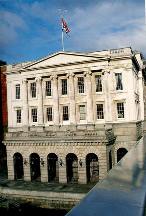Visit Reports
Fishmongers’ Hall
Tour + Lunch 29th November 2010
The Fishmongers’ Company is the 4th in precedence of the Twelve Great Livery Companies and came into existence in the 13th century. It was not until
the 15th century that the first Hall was constructed out of the premises of three prominent fish merchants located on a key site on the North Bank of
the Thames. On 2nd September 1666 it was one of the first buildings to be destroyed by the Great Fire. The replacement building of redbrick and stone
stood until it was demolished in 1831 to make way for the enlarged new London Bridge. So it was the Third Hall that we had the pleasure of visiting on
29th November. It was built between 1831 and 1835 after a design competition featuring 87 entrants.

This 19th century Fishmongers Hall is an imposing and elegant stone faced building, with an arched colonnade facing Bankside and Southwark Cathedral from its wonderful prominent position beside London
Bridge. When it was opened it was the tallest building in London. The magnificent Thames views from the main rooms call to mind the importance and the bustle of commercial life of this water highway through
the centuries.
Our tour began with coffee in the Court Room and was lead by Claire Crawford, the curator, who was outstanding with her description of both the
Fishmongers Hall and the Company. Some of the most interesting paintings of historical Thames and London Bridge views were hanging in the Court Room,
together with the hand carved Coats of Arms of the most recent Prime Wardens such as Prince Philip, and the Duke of Devonshire. My favourite painting
there was the Interior of Billingsgate Market at 6 a.m. by Hicks, showing all London life. It apparently made a huge impact when first displayed at the
Royal Academy.

After an hour of fascinating description from Claire, we toured the rest of the Hall seeing a very early embroidered funeral pall,
a small part of their extensive silver collection, a carved 1684 wooden statue of Walworth, a Prime Warden of the Fishmongers Company
who became Lord Mayor of London. It was he who stabbed Wat Tyler for insulting the monarch during the Peasants’ Revolt.
It was a surprise to find the originals of the two Annigoni portraits of the Queen and Prince Philip hanging there. In fact we enjoyed an
excellent lunch of roasted fillet of salmon under the serious gaze of the young Queen Elizabeth in her Garter robes in the famous portrait
that we all remember from the 1950s. The portraits were in fact commissioned by the Fishmongers and Annigoni painted them at Buckingham
Palace from 16 sittings. In each one there is a tiny figure of Annigoni himself to be found in the background.
I had been looking forward to this visit for some time and I know that everyone felt they were privileged to have experienced an exceptional,
informative and enjoyable day. Fortune smiled on us that day because later that night the snow fell and travel was reduced to customary British chaos.
Carole Sugden December 2010
